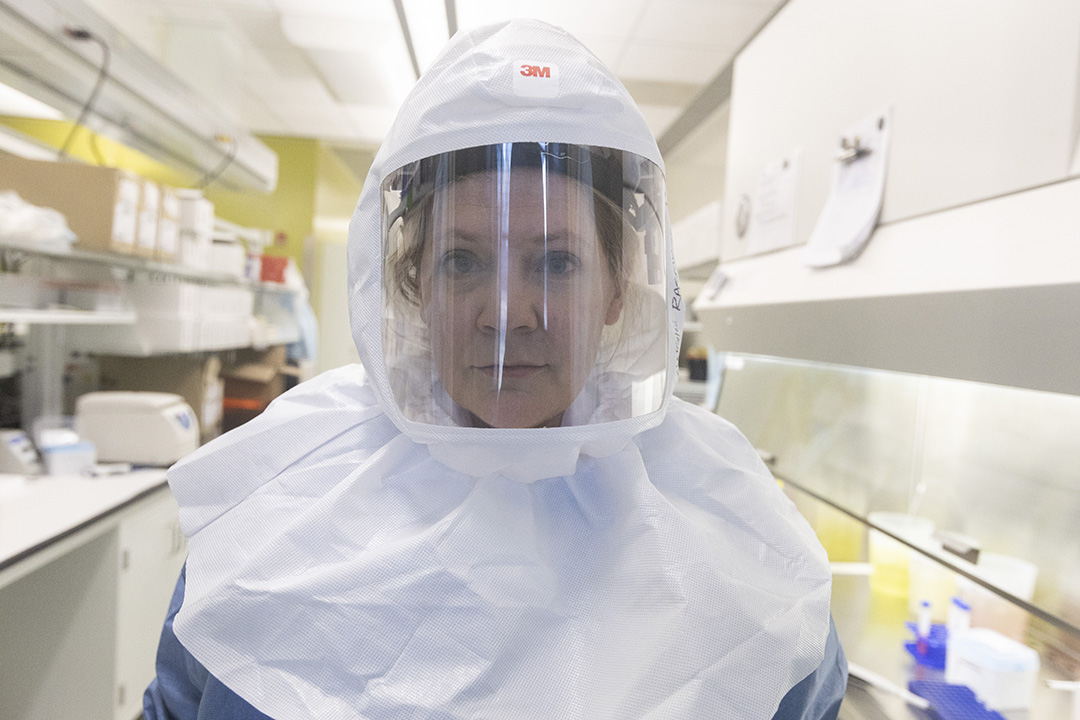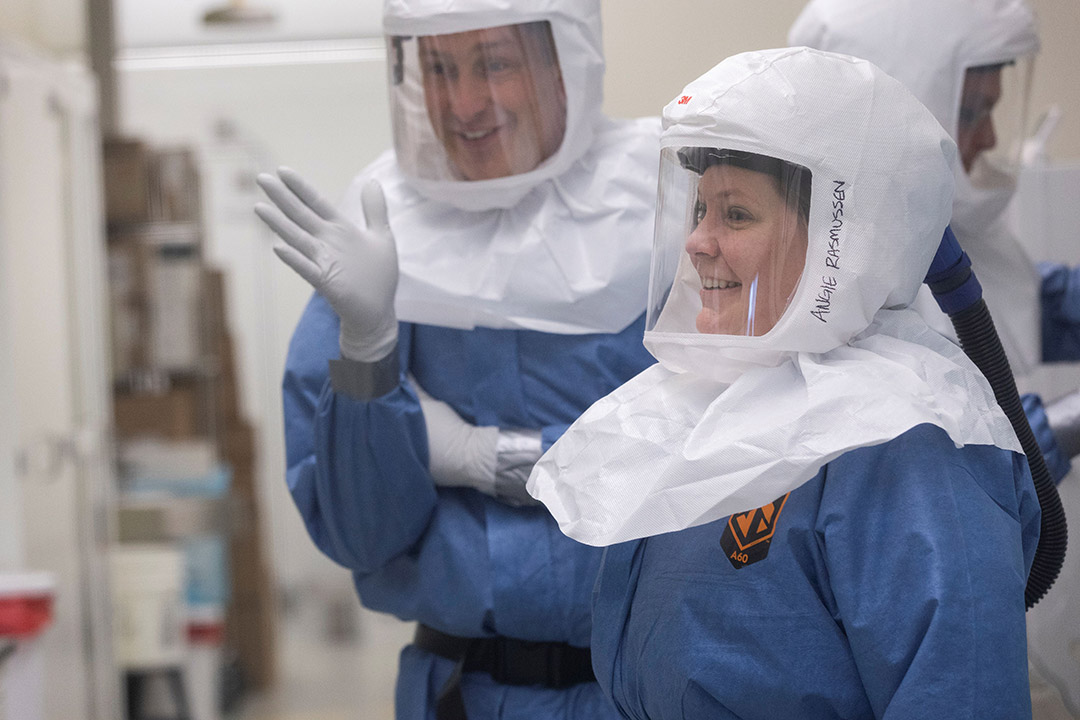
VIDO virologist: Renowned researcher at USask leads pandemic fight
She is one of the world’s most recognized virologists, recruited to serve on the front lines of the pandemic and preparing for the next global threat.
By James ShewagaRenowned researcher Dr. Angela Rasmussen (PhD) of the Vaccine and Infectious Disease Organization (VIDO) at the University of Saskatchewan (USask) has also become a voice of reason in an online world corrupted by conspiracy theorists and anti-vaxxers, fighting back on social media and in major mainstream media publications. While her focus is on work in the lab that has global impact and can help save millions of lives, Rasmussen is also dedicated to clearly communicating the science behind the research.
“You can’t have public health without the public’s engagement and participation, and I think the key to doing that is to actually help people to understand what is going on,” said Rasmussen, who left Ivy League research institute Columbia University in New York and moved to Saskatoon in 2021 with her husband to join VIDO as a principal research scientist and USask as an adjunct professor. “When the pandemic started, I had 250 Twitter followers and now I have 420,000. I definitely did not expect to be playing this role, although I am glad that I am because I think that I do bring something unique to the table and that is because I am pretty blunt and pretty direct …
“It is a never-ending battle. It really is a Sisyphean endeavour to push back against disinformation, but you have to do it. And I seem to be OK at it, and it certainly helps me have an appreciation for how important communication is, particularly with the public.”
Looking back at the last three years since the World Health Organization declared the coronavirus outbreak a pandemic on March 11, 2020, Rasmussen said the global response and concerted collaboration to create vaccines to fight COVID-19 was one of the greatest scientific success stories of our time. But the politicalization of the pandemic, the growth of the anti-vax movement, and the relaxing of public health measures worldwide before the COVID-19 crisis was over, have been frustrating for Rasmussen and many in the scientific community who have been battling a global outbreak that has killed millions.
“I was pleasantly surprised by how fast vaccines were developed, but almost everything else has not gone very well,” said Rasmussen. “So, I am disappointed and surprised by that, because pandemic preparedness really is an area that people have been working on for a long time. These vaccines have really profoundly changed the trajectory of the pandemic in the sense that they are proven to have stopped people from dying and being in the hospital. And if more people had been vaccinated and if more people had access to them—which is also an important component of this—we would have saved even more lives.”
Three years into the pandemic, 1,913 people are confirmed to have died from COVID-19 in Saskatchewan, 50,224 in Canada, and 6,879,677 worldwide, with most countries having reduced or eliminated public health measures, including mandatory masking in public places or vaccination requirements. Rasmussen said she completely understands the general public’s frustration and many individuals’ desire to get back to normal, despite the ongoing risks.
“I don’t blame the general public at all for throwing in the towel about things like masking,” she said. “Unfortunately, after three years, people are exhausted. But what I am frustrated about is the fact that we—and by ‘we’ I mean the world—have not encouraged people to uniformly adopt wearing masks and getting vaccinated. It turned into a political football, rather than something that should be considered across the board as the public health issue that it is.”

Rasmussen pulls no punches in her public fight with the anti-vax movement, noting how many high-profile conspiracy theorists are profiting off the pandemic, while spreading doubt over the safety of vaccines and questioning how quickly they were approved. Rasmussen notes that the science behind the current COVID-19
Messenger ribonucleic acid (mRNA) vaccines and clinical trials go back more than a decade.
“The anti-vaxxers are exploiting people’s lack of science education, lack of understanding of complex topics, and frankly they are good storytellers. It is a lot more exciting to listen to a story about a conspiracy theory than it is to hear the mundane truth about how mRNA vaccination is safe and effective,” said Rasmussen. “And we saw a lot of people become very wealthy by doing things like prescribing ivermectin and hydroxychloroquine and all sorts of things as alternatives to vaccination.
“I have been communicating and having a lot of public-facing conversations about this, so I really get to see first-hand how rampant and prevalent disinformation is. I am originally from the U.S., but political and anti-science sentiment in the U.S. and Canada and other places around the world has been incredibly frustrating and demoralizing.”
While Rasmussen has been encouraged to see global hospitalizations and death rates slowly dropping overall, she cautions against believing the pandemic has run its course.
“I am reluctant to say that because there are a lot of variables that could impact this,” said Rasmussen. “We could have a new variant emerge different from Omicron that could be very unpredictable. So, I never underestimate RNA viruses’ ability to evolve. But that said, everybody for the most part in Canada is either vaccinated and/or has had Omicron, so we do have a sufficient level of population immunity and seeing a de-coupling between the number of cases and the number of deaths and hospitalizations, which is good.
“Theoretically, this would fall into endemicity, in the sense that it would be predicable. We would know that it is flu and COVID season, so get your COVID shots. But I think it is a little premature still to say that.”
What does concern Rasmussen and her colleagues is the knowledge that the next pandemic—involving an entirely different pathogen—could be much more devastating than COVID-19 or the deadly influenza pandemic caused by the H1N1 influenza A virus a century ago that killed an estimated 25-50 million worldwide.
“What keeps me up at night is, A) that we might not be working fast enough to prepare for the next one, and B) that we are spending too much time talking about political things and not enough time talking about the real threat,” she said. “Really, the real threat is the entire world full of more transmissible zoonotic viruses that could potentially emerge.”
Rasmussen notes that the current COVID-19 pandemic—officially SARS-CoV-2—had a case fatality rate of 2-3 per cent before vaccines were distributed. For Rasmussen, the thought of avian flu widely infecting the human population, or the evolution of a more transmissible Middle East respiratory syndrome (MERS) coronavirus—with a case fatality rate of 30 per cent—or the emergence of a more transmissible version of the nightmarish Nipah virus—which kills 40 to 75 per cent of those infected, according to the WHO—could be catastrophic.
“Can you imagine if one of every three, or one out of every two people who caught COVID would die from it? I think that is something that could potentially cause civilization to collapse, and I do not think that is actually that hyperbolic of an assumption,” said Rasmussen. “So, something like that keeps me up at night. That would be a ‘does anybody have a survival bunker?’ kind of situation. And that really does scare me because there certainly are viruses out there that have that capability.”
Rasmussen said the highly pathogenic H5N1 avian flu, which has killed more than 100 million birds worldwide since the outbreak began in 2021 and has close to a 50 per cent death rate in rare human infections, is a prime example of the increasing dangers of zoonotic viruses, transmitted from animals to humans. So why are these outbreaks becoming more frequent?
“One reason is mobility: we can go all over the world in a matter of hours (and spread emerging viruses),” said Rasmussen. “Also, we are developing and using land in different ways, encroaching on wild spaces, and coming into contact with species that we didn’t have contact with before, disrupting ecosystems and forcing new interactions with wildlife. And the final reason is climate change. For example, mosquitos that carry dengue virus and chikungunya virus are expanding their geographic range because the planet is getting warmer and now there are more places that they can live in. So, it might seem like viruses are getting worse, but we are creating the conditions for those viruses to get into people more often.”
Dealing with doomsday scenarios is what drives world-leading researchers like Rasmussen to try to better prepare for the next pandemic. And the renewed commitment to this broad field of research at VIDO—both in terms of people power and financial backing from federal and provincial governments and private donors—is what drove her to the USask campus.
Rasmussen said she is extremely encouraged by the work of her dedicated colleagues on campus at USask and with VIDO’s emergence as Canada’s Centre for Pandemic Research. With the construction of a new state-of-the-art vaccine manufacturing facility and VIDO soon to be home to the only non-government containment Level 4 facility in the country, she is proud to be a part of Saskatchewan’s emergence as a global leader in the battle against emerging infectious diseases.
“I was recruited here because of VIDO’s transition to becoming the national pandemic research centre, so I think certainly Canada is making the investment, although there is a lot more work to be done,” said Rasmussen. “I knew my (VIDO) colleague (Dr.) Darryl Falzarano (PhD), so I had heard of VIDO before, but I had never been to Saskatoon or even in the province at all. But I was just really impressed with seeing what VIDO had done within Canada, and seeing the investments that are being made in VIDO, as well as (VIDO Director) Dr. Volker Gerdts’ (DVM) vision for what VIDO can become. We are doing great research here.”
Together, we will undertake the research the world needs. We invite you to join by supporting critical research at USask.

